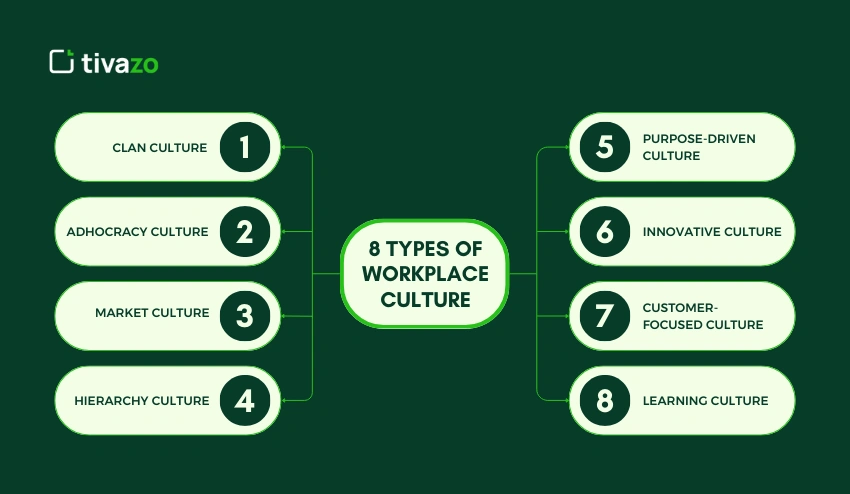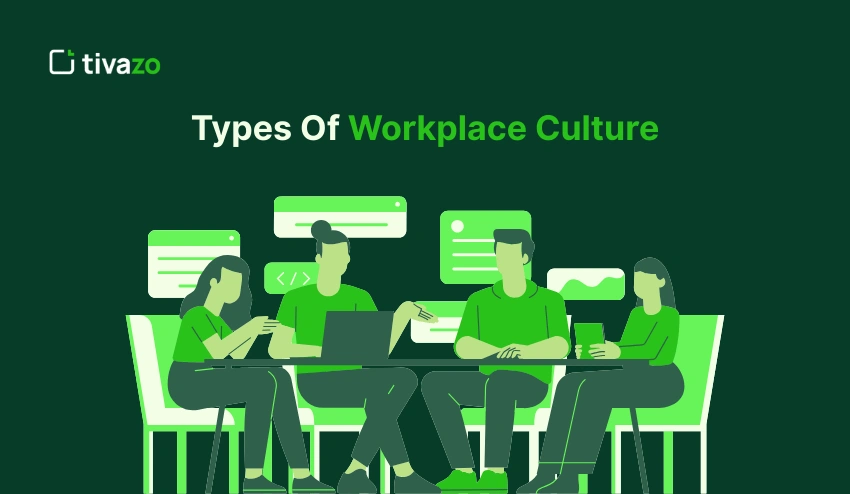Workplace culture is not some trendy phrase, but the unseen power that determines the way employees work with each other, innovate, and get results daily. The appropriate culture can enhance participation, build teamwork, and lead to organizational success.
It is imperative that leaders understand the various types of workplace culture so that they can align their teams, bring the best talent on board, and have a friendly work environment. Between creative, risk-taking cultures and formal, process-driven organizations, each type of culture has its own impact on the performance, employee satisfaction, and development of the company.
In this article, we will discuss the most popular types of workplace culture, such as clan, adhocracy, market, hierarchy, and other forms that affect the way organizations are run. By determining the type of culture your organization has, you can apply measures that can improve teamwork, employee involvement, and productivity. Whether you are developing a new team or redesigning an existing team, the initial step to developing a successful workplace is to understand the various types of workplace culture.
What Type of Culture Is Best for the Workplace?
Which is the best types of workplace culture is a question that relies on your organization and its objectives, industry, and your team dynamics. Although no single solution fits all, studies have found that a culture founded on a balance between collaboration, innovation, and accountability is likely to produce the greatest levels of employee engagement and productivity. A survey conducted by Deloitte shows that firms whose culture is strong and flexible achieve higher growth in revenues and retention of employees as compared to their competitors.
In fact, adhocracy and the innovative culture, which value creativity and risk-taking, tend to flourish in organizations located in tech centers such as San Francisco or Bangalore. In the meantime, more traditional industries like finance in London or manufacturing in Germany may have advantages of hierarchy or cultures of market that give stability, defined functions, and results based on performance.
After all, the most successful types of workplace culture are those that conform to the vision of your organization and ensure that employees are able to work to their best ability. Leaders can adopt approaches that encourage engagement, cooperation, and long-term growth by recognizing the various types of workplace culture in their teams, be it in New York, Sydney, or Singapore.
8 Different Types Of Workplace Culture
Culture at work is vital in determining how employees act, participate, and the overall success of an organization. Knowledge of the various types of workplace culture assists leaders in developing environments in which teams succeed and businesses prosper.

1. Clan Culture
Clan culture is a people-oriented types of workplace culture based on collaboration, teamwork, and a family-like atmosphere. Staff members are treated like they are part of a large family, and the company promotes loyalty, mentorship, and a sense of belonging. This type of workplace culture is more focused on the participation of employees and their health, which is why it is a perfect fit for companies that desire a good internal relationship.
The culture of the clan promotes openness, inclusion, and an inclusive environment where members are made to feel appreciated. Leaders usually become mentors and not bosses, which builds more trust and friendship. A clan culture is characterized by organizations that are usually interested in the growth of the skills of their employees and in ensuring favorable working conditions in the organization that discourage employee turnover.
This type of workplace culture is especially useful in small to medium-sized companies where group unity and spirit are vital. Clan culture will promote productivity through mutual support and collaboration, as well as building a good reputation in the organization.
Benefits:
- High employee engagement and loyalty
- Strong team collaboration and communication
- Low turnover rates
- Supportive and inclusive work environment
Example: Zappos and Southwest Airlines are well-known for embracing clan culture, focusing on employee satisfaction and team cohesion.
2. Adhocracy Culture
Adhocracy culture is an innovative, dynamic among different types of workplace culture that places a high value on creativity, risk-taking, and experimentation. Companies that practice adhocracy culture encourage their staff to think beyond the box and create new answers to business dilemmas. It is a culture that is successful in an environment where hierarchy and bureaucratism are not important values.
In an adhocracy culture, management gives teams the authority to decide, to explore and test new ideas, and to adjust swiftly when circumstances alter. What drives the employees will be the need to discover new, unusual approaches, and as a result, they will create innovative products and services. It is best suited to startups and technology-focused companies and is focused on flexibility, problem-solving, and continuous growth.
Such an organizational culture promotes entrepreneurial thinking and responsiveness so that organizations promptly respond to changes and customer requirements in the market. Adhocracy culture helps to distinguish a company in competition by encouraging creativity and innovation.
Benefits:
- Encourages innovation and creative problem-solving
- Supports risk-taking and experimentation
- Promotes adaptability and agility
- Attracts creative, proactive employees
Example: Google and Tesla are prime examples of companies with an adhocracy culture, emphasizing innovation and dynamic work environments.
3. Market Culture
A market culture is an outcomes-oriented type among other types of workplace culture that focuses on competition, success, and performance goals. Organizations that have a market culture are more focused on quantifiable results, productivity, and customer satisfaction. Goals, performance measures, and rewards motivate employees.
In such a workplace culture, leadership involves results and accountability and moves teams to perform well in their given roles. Employees are commonly judged by success, and success is gauged by KPIs, sales, or market share. Market culture establishes a culture of performance in which high performance is rewarded.
Market culture works best in competitive markets where profitability and expansion are the most important factors. This types of workplace culture provides high performance of teams and companies by making sure that the organizational goals are aligned with specific measurable outcomes.
Benefits:
- Strong focus on productivity and results
- Clear performance expectations and accountability
- Encourages goal-oriented behavior
- Enhances market competitiveness
Example: Amazon and General Electric (GE) are known for their market culture, emphasizing performance and measurable results.
4. Hierarchy Culture
Hierarchy culture is also an organized types of workplace culture that focuses on order, rules, and stability. Predictability, efficiency, and clear responsibilities are appreciated in organizations where the corporate culture is hierarchical. Employees work on a formal chain of command, and processes and decisions are consistent.
In this types of workplace culture, leadership practices, standardization, risk management, and policy compliance. Communication is formal, and the way things are done is systematic to avoid human error. Hierarchy culture is quite useful in a big organization or industry where compliance, safety, and accuracy are paramount.
Such a workplace culture promotes accountability and reliability, and it assists organizations in achieving quality and operational excellence on a regular basis. Employees know their roles and expectations, and this eliminates confusion and ensures stability.
Benefits:
- Clear roles and responsibilities
- Stable and predictable work environment
- High operational efficiency
- Minimizes errors and ensures compliance
Example: IBM and government agencies exemplify hierarchy culture through structured operations and standardized processes.
5. Purpose-Driven Culture
A culture of purpose is a workplace culture in which organizations focus on a common mission or values, usually associated with social impact or ethics. When employees have a sense of contributing to something bigger than profit, they are motivated. Through this culture, there is engagement and loyalty among the employees who share the organizational vision.
A purpose-driven culture is one that incorporates its mission in all areas of its operations, including the way it hires its staff. The focus of leadership is on ethical conduct, sustainability, and meaningful work, which tie the workforce to the goals of the company. When the work they do has a bigger purpose, employees feel empowered and inspired.
Culturally focused on purpose fosters corporate social responsibility and draws the attention of individuals who are interested in making meaningful contributions. These types of workplace culture also enhance brand reputation and customer trust.
Benefits:
- High employee engagement and motivation
- Aligns workforce with organizational mission
- Enhances corporate social responsibility
- Attracts purpose-driven talent
Example: Patagonia and TOMS Shoes are purpose-driven organizations focused on environmental sustainability and social impact.
6. Innovative Culture
The innovative culture focuses on ongoing improvement, learning, and creativity in an organization. The workers are stimulated to come up with new ideas, streamline operations, and disrupt the usual way of thinking. This kind of work ethic promotes flexibility and growth in the long term.
Innovative culture Leadership promotes research, cross-functional collaboration, and experimentation. An error is seen as a learning chance, a non-threatening environment in relation to innovation. Innovative culture organizations invest in the development of their employees and promote new thinking to remain competitive within businesses.
Innovation helps organizations to improve their problem-solving and to keep up with the ever-changing industries. In this culture, the employees are encouraged to maximize processes, products, and services.
Benefits:
- Promotes creativity and new ideas
- Encourages continuous learning and improvement
- Supports adaptability and resilience
- Drives long-term organizational growth
Example: Apple and 3M are renowned for their innovative culture, consistently introducing groundbreaking products.
7. Customer-Focused Culture
Customer-centred culture is a types of workplace culture in which organizations are concerned with customer satisfaction and service quality. The employees are oriented to learn the customer needs, provide good service, and develop long-term relationships. This culture keeps customers at the top of business decisions.
In a customer-oriented culture, leadership is based on empathy, responsiveness, and feedback loops. Employees are given the authority to resolve customer issues in a fast and efficient manner to create an enjoyable experience that builds loyalty. Firms in this culture tend to rely on customer feedback to spur improvement and innovations.
Customer-first mentality can help organizations to stand out in competitive markets and boost their profits as a whole. The culture of customer orientation contributes to the satisfaction of employees and customer confidence.
Benefits:
- Improves customer loyalty and retention
- Enhances brand reputation
- Encourages employee responsiveness and empathy
- Drives revenue growth through customer satisfaction
Example: Ritz-Carlton and Nordstrom exemplify a customer-focused culture with exceptional service standards.
8. Learning Culture
A learning culture is a types of workplace culture that embraces lifelong learning, skill building, and knowledge exchange. This type of culture offers training, mentoring, and personal and professional development in organizations. The staff is stimulated to broaden their potential and become lifelong learners.
A learning culture leadership invests in the development of workers and instills the spirit of betterment and creativity. Knowledge sharing practices assist in disseminating expertise within the organisation and facilitate cooperation and problem-solving. Such a workplace culture will make the employees flexible in fluctuating industries.
An effective learning culture enhances employee retention and job satisfaction and prepares the workforce to address new business challenges. When employees perceive growth and career advancement opportunities, they will be more involved.
Benefits:
- Enhances employee skills and performance
- Promotes adaptability and a growth mindset
- Improves knowledge-sharing and collaboration
- Increases employee retention and satisfaction
Example: Deloitte and Microsoft are known for their learning culture, investing heavily in employee development programs.
Recognizing the various types of workplace culture enables organizations to develop climates that will improve employee engagement, teamwork, and performance. Companies can become long-term successful and foster working environments that allow employees to flourish by recognizing and purposefully developing an appropriate culture.
What is a toxic workplace culture?
Toxic workplace culture is a types of workplace culture in which stress, low morale, and low employee engagement are the results of ineffective leadership, communication, and unprofessional conduct. The research states that firms that practice a toxic culture experience very high turnover, and productivity is low.
It can be a New York office or a technology center in San Francisco, or a factory in Berlin. By building a culture of collaboration, recognition, and open communication, it becomes easier to transform a toxic culture into a positive culture, leading to better retention, innovation, and overall performance.

How to Assess and Build the Right Workplace Culture
1. Assess Your Current Culture
Carry out surveys, interviews, and focus groups to get feedback on the current culture among employees. In this step, various tools may be useful, such as the Organizational Culture Assessment Instrument (OCAI).
2. Define Your Desired Culture
Depending on the mission, values, and goals of your organization, identify the most appropriate types of cultures. Take into account such factors as industry, size, and workforce demographics.
3. Implement Cultural Initiatives
Create programs and policies that advance the desired culture, including leadership programs, recognition programs, and communication plans.
4. Monitor and Adjust
Periodically review the success of cultural programs and implement changes where necessary to make them fit the requirements of the organization.
Conclusion
It is important to know the different types of workplace culture for those organizations that want to establish a workplace culture that is similar to their organization’s goals and values. We can improve employee engagement, performance, and long-term success by evaluating and developing the appropriate culture.
What kind of workplace culture would you say best corresponds to the mission and values of your organization?




